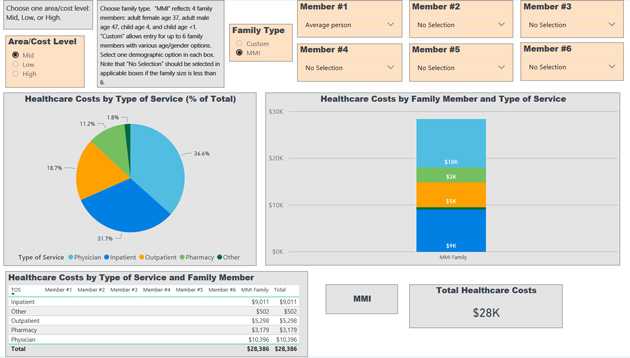In 2019, the cost of healthcare for a hypothetical American family of four covered by an average employer-sponsored preferred provider organization (PPO) plan is $28,386, according to the Milliman Medical Index (MMI).
Key findings of the 2019 MMI include:
Healthcare costs are increasing at a slower rate, by historical standards. Back in the early 2000s, healthcare expenses for the MMI family of four were growing by 10% a year. Now, nearly 20 years later, growth rates are at record-low levels. We estimate that costs grew by only 2.9% from 2017 to 2018, and then by a moderately higher 3.8% from 2018 to 2019.
Prescription drug trends are low. With the public spotlight shining squarely on the high cost of prescription drugs in the United States, one might think that drugs have been a major cost driver for our MMI family of four. However, while their level of costs may be high, their rate of growth has been relatively modest the past few years. We estimate that drug costs for the family increased by approximately 4.5% from 2017 to 2018, and then by only 2.1% from 2018 to 2019. However, past volatility in prescription drug expenses has taught us that these rates can jump significantly, up or down, continuing the uncertainty around future growth rates. As discussed later in this report, national attention has also focused on prescription drug rebates, whose impact on net drug expenses has become increasingly important.
Employer costs increase more than employee costs… this year, at least. The healthcare costs highlighted in the MMI are funded by employer contributions to health plans, and by employees through their payroll deductions and out-of-pocket expenses incurred when care is received. Over the 19 years that we have tracked the MMI, the long-term trend has been for employees to pay an increasingly higher percentage of total costs. However, from 2017 to 2018, that trend was disrupted—possibly due to low unemployment rates and a relatively strong economic outlook—with employer contributions increasing by 5.1% and employee cost growing by less than 1%. From 2018 to 2019, we estimate that employer versus employee contribution rates have grown at similar rates, 3.6% versus 4.0%, respectively. The ebb and flow of “who pays more” will likely continue, as discussed later in this report, but as healthcare growth rates moderate, so too might the shift of costs from employer to employee.
New this year: Build your own family. Since its first publication in 2005, the Milliman Medical Index (MMI) has proven a valuable measure of average healthcare costs and changes in those costs for a hypothetical “typical American family of four.” In prior years we have defined that family as a male age 47, a female age 37, a child age 4, and a child under age 1. In reality, family compositions vary, and families can have extremely different levels of healthcare expenses. This variation results from differences in family size, the family members’ ages and genders, where they live, their income levels, their unique health conditions, and a host of other variables. With this in mind, we have launched a new tool that allows readers to select different demographics for family members and understand their unique healthcare costs.
Visit the MMI interactive tool to build your own family and understand their healthcare costs
Share your results on social media using the hashtag #MMIndex19.
